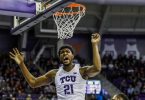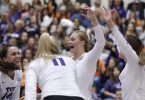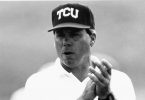When eight players elected to transfer — more than Jim Schlossnagle can recall in any year in his time as coach at TCU — it could be seen as good news and bad news.
The bad news is, it meant the starting shortstop and right fielder were gone, plus three bullpen arms, the backup catcher, a backup infielder and a backup outfielder.
The good news is, such exoduses usually mean a major talent infusion is on the way. Players don’t just get up and leave for no reason.
“A lot of times it’s a mutual decision, and it’s a good thing,” Schlossnagle said, reflecting on the departures of shortstop Adam Oviedo, right fielder Andrew Keefer and others. “Each individual situation is different. Baseball is a sport where, for a lot of players, if they can get an opportunity to play and show what they’re capable of doing, then there’s a chance to be drafted into professional baseball.”
Also electing to transfer since season’s end were pitchers Dawson Barr, James Notary and Spencer Arrighetti, infielder Dean Frew, outfielder Brad Czerniejewski and catcher Nick Juaire.
“Every kid’s dream is to play some level of professional baseball,” Schlossnagle said. “I try to be honest with them about where they are in the program and how they fit in and what their playing time may or may not look like. I think they appreciate that. That way they’re free to make a decision on their own personal future.”
So how good is the incoming class? It’s headlined by three national top 100 players — pitchers Riley Cornelio and Jacob Meador and catcher Kurtis Byrne. All but one of the signees — first-round draft selection Quinn Priester, a pitcher who signed with the Pittsburgh Pirates — are TCU property following the MLB deadline July 12.
It’s a change from 2018, when four of the Horned Frogs’ top five signees said yes to pro ball, and 2017, when the top three did.
“There are some guys we’re super-excited about, especially on the mound,” Schlossnagle said. “Two or three of the better high school pitchers in the country made it to campus.”
More help is on the way in players TCU already has. Russell Smith is throwing off a mound, and Caleb Sloan is “progressing nicely” following their Tommy John surgeries before last season. Marcelo Perez is in a throwing program after his season was cut short two weeks before postseason by a shoulder strain.
“One of the bigger keys to our season will be how those guys come back and help us, those three pitchers,” Schlossnagle said.
Designated hitter Porter Brown is rehabbing in Fort Worth from his season-ending dislocated shoulder, suffered in a game in March, one inning shy of being ineligible for a redshirt year.
More roster change may be inevitable, with around 16 holdovers on top of 23 new players, including walk-ons. College baseball teams have only 11.7 scholarships to spread out to a maximum of 27 players (each receiving a minimum 25 percent of a full scholarship) on a roster of 35.
Schlossnagle grins only a little when he calls it a salary cap.
“With limited scholarships, the major league draft, small roster size and the fact that we have to recruit a lot of these kids super early, before we have any idea of what a roster’s going to look like two to three years later, sometimes it leads to some last-minute changes on behalf of the player or program,” he said.
Still, TCU can label its summer a success so far. Right-hander Matt Rudis had an 0.69 ERA in his first three starts in the New England Collegiate Baseball League, and infielder Bobby Goodloe hit .327 in the first 29 games of the 38-game season in the Alaska Baseball League, each player gaining valuable experience.
Senior right-hander Charles King gives the Frogs an excellent starting point in building a rotation or a bullpen. Senior arms Jake Eissler and Haylen Green also opted against signing professionally, as did senior catcher Zach Humphreys, whose bat in May helped point the way to postseason.
If Schlossnagle could have had one more wish, it would have been to keep leading hitter Jake Guenther. But when the slugger’s name came up in the seventh round in June, the junior from Oshkosh, Wis., was gone after one wall-banger of a year in Fort Worth.
“Up until about the last two weeks before the draft, we expected him back,” Schlossnagle said. “He changed his heart on what he was willing to sign for. That therefore led to him being drafted in a spot where he would sign. If he would have come back, it would have been perfect. But considering what we’ve gone through the last three years, prior to this year, we’ll take it.”







